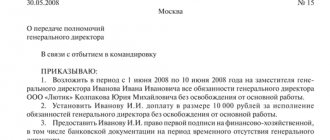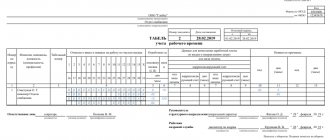Business trips - the diversion of employees from their permanent place of work, trips to carry out assignments from management - must be properly documented. Previously, the official assignment was issued together with a travel certificate and an order for the organization. What role does a job assignment play when going on a business trip nowadays, how to draw up a document and what are the rules for document flow regarding it - more on that below.
- Form and sample
- Free download
- Online viewing
- Expert tested
FILES
What documents does a business traveler need?
An employee sent on a business trip is subject to serious requirements for paperwork - the papers confirm the company's expenses, controlled by the fiscal authorities.
The current version of Government Decree No. 749 dated 10/13/08 speaks of the need:
- written order from the administration to go on a business trip;
- advance report on business expenses.
All entries in the advance report are confirmed by primary documents (travel, living expenses, etc.). The written order is issued in the form of a business trip order, which briefly describes, among other things, its purpose.
Despite the reduction in documentation for business trips at the legislative level, many personnel officers continue to issue both a travel certificate and an official assignment for a business trip, believing that the mandatory documents specified in the legislation are not enough to fully account for the business trip.
Both the order and the job assignment reflect the goals set by management for the employee. The job assignment has a number of features.
Instructions: before the start of the business trip
So, let’s look at filling out a document for sending on a business trip step by step using the unified form T-10a as an example. The form established by Goskomstat or the employer is drawn up for the purpose of correct accounting and payment of travel expenses.
Step 1. Fill out the header
We begin filling out the sample business trip assignment by entering general information:
- name of the institution;
- numbers of forms according to OKUD and OKPO;
- serial number;
- date of formation.
Step 2. Fill in the employee’s personal data
A sample job assignment for a business trip (format T-10a job assignment you could see above) contains information of a personal, individual nature:
- FULL NAME. the employee must be listed in the center of the form;
- The number on the timesheet is recorded in the same part.
Step 3. Fill out the table
The form “Office assignment for a business trip in 2021,” a sample of which can be studied further, contains a table consisting of 12 columns, the first 11 of which are filled in in order with the following information:
- Fixation of the structural unit where the person works.
- The title of the position is in accordance with the wording in the staffing table of the institution.
- Name of the area where the employee needs to be sent.
- Full name of the institution where the employee is going.
- Trip start day.
- The day the trip ends.
- The total duration of the trip.
- Duration, excluding travel time.
- An indication of the institution that pays travel expenses (usually the one that sends the employee, sometimes the inviting party).
- Information from the administrative document according to which the employee is sent on the road.
- Description of the purpose of the employee's referral.
Having filled out the first 11 columns, the registration can be interrupted until the employee returns from the trip.
Step 4. Sign
The process should be completed by ensuring the signature of the head of the structural unit where the person leaving works. In general, the document must be approved by the head of the institution (a person authorized by the head).
Is a job assignment required?
Resolution No. 749 does not mention this type of document, and therefore it is considered that the organization has no obligation to draw it up. If the business trip is urgent, it is easier to get by with a written order for the organization; this will not be considered a violation. However, if a serious long trip is ahead, the employee should still present the task in the clearest, most detailed form, in a separate document. Usually, a memo or, more familiar to the employee and management, an official assignment is drawn up.
It not only indicates the purpose of the trip, as in the order, but also provides a more detailed list of tasks that the seconded employee must perform to achieve it. This detailed form of presenting the task is convenient: it makes it possible to avoid misunderstandings and inaccuracies when carrying out an official assignment to an employee and to easily monitor the execution of the administration.
A travel assignment is considered an internal document; its application must be reflected in local acts relating to business trips (Article 8 of the Labor Code of the Russian Federation).
On a note! Order No. 558 of the Ministry of Culture dated 08/25/10 on the list of management documentation and storage periods for documents under No. 669 specifies documents on the secondment of employees, including official assignments.
Their shelf life is 5 years, and 10 years for business trips abroad.
Who issues the official assignment and who must sign it?
The execution of a job assignment for a seconded employee can be entrusted to his immediate superior, for example, the chief engineer, if an ordinary engineer is sent on a secondment. Quite often, the registration is carried out by an employee of the personnel service on the basis of a memorandum from the head of the department, approved by the head of the company.
The written assignment for a business trip is signed by:
- head of the company;
- head of a structural unit;
- the worker himself.
The number of copies of the document is specified in the LNA. Most often they are limited to one copy. The task is issued to each employee separately, even if they are sent on a business trip as a group, according to the order.
The head of the company, going on a business trip, draws up an official assignment for himself as an employee and signs it himself.
The document provides not only the task as such, but also a report upon return from a business trip on its execution. It must be provided to management regardless of whether the approved T-10a form is used or a free one adopted by the company and enshrined in a local act.
After the end of the trip, the task is submitted along with the advance report and documents confirming the expenses. If the organization's document flow provides for a travel certificate, it is also attached to the package.
On a note! If the use of an official task is prescribed in the LNA, the employee is obliged to report in writing on the execution, otherwise he will be punished under the Labor Code of the Russian Federation, Art. 192.
Business trips in legislative acts
The concept of a business trip, the principle of reimbursement of expenses spent during business trips, as well as guarantees for employees on a business trip are established by the provisions of Articles 166 - 168 of the Labor Code of the Russian Federation.
In addition to the Labor Code, issues of sending employees on business trips are regulated by Decree of the Government of the Russian Federation No. 749 of October 13, 2008, the provisions of which established the procedure for sending employees on business trips and the requirements for its documentation. However, four years ago, by resolution No. 771 of July 29, 2015, some changes were made to these regulations.
Summary of changes
As a result of these changes, the following documents used for official travel lost their mandatory status:
- travel certificate - now travel documents issued in the name of the employee sent on a business trip are accepted as documents confirming departure for a business trip and return from it. In cases where the employee traveled to the destination point by official or personal transport, an alternative to travel documents is a travel document or route sheet;
- official assignment – after the changes have been accepted, the owner has the right not to issue a business assignment. It is considered sufficient to indicate the purpose of the trip in the order for the enterprise sending the employee on a business trip;
- report on the completion of a service assignment - at the moment, you can use the unified form No. T-10a, which contains both information about the service task and a report on its completion. It is also allowed to use business trip report forms independently developed by the employer, provided that such a form is approved in accordance with the established procedure and is included in the nomenclature of affairs and accounting policies of the company;
- journals for registration of travel certificates are completely canceled, but can be maintained at the discretion of the employer.
Composition of the document
A service assignment for a posted employee, drawn up in any legal way (on a unified form or without it) contains certain details:
- Document header. Consists of the name of the document, number, date, name of the company that sent the employee on a business trip.
- Information about the posted employee. Full name, position, personnel number, department to which it belongs.
- Business trip information. This will include the name of the receiving party, the location of the business trip, its expected start and end dates. Indicate the number of days of the business trip, including those without being on the road. Form T-10a provides the name of the organization that pays for the business trip. Usually this is the same company where the business traveler works. If the document is drawn up in free form, according to the rules of internal LNA, this paragraph may be omitted, meaning by default.
- Base. The details of the base document are indicated here. Most often this is a business trip order, but there may also be another document, for example, a remote work plan if a technical specialist is sent on a business trip.
- Exercise. Enter the purpose of the trip, point by point.
- Report on the completion of the task. This item is filled out after the employee returns either by himself or by his immediate supervisor, who is able to objectively assess whether the subordinate has completed the assigned task.
- Signatures. The head of the company, the department and the employee himself sign. A separate paragraph includes a resolution on the completion of the task and the signature of the head of the unit under it (for the second time, upon the employee’s return).
In many cases, the T-10a form is not used because it has limited fields to fill out. If the content of a job assignment is voluminous, it is inconvenient to fill out such a document. Then a free form is used with the inclusion of the above data.
GLAVBUKH-INFO
The purpose of the employee’s business trip is determined by the head of the sending organization and is indicated in the official assignment, which is approved by the employer (clause 6 of the Regulations on Business Travel).
To draw up a job assignment, a unified form N T-10a is provided (approved by Resolution of the State Statistics Committee of the Russian Federation dated January 5, 2004 N 1). The job assignment is the basis for issuing an order to send an employee on a business trip and issuing a travel certificate. The column “Name of organization” must indicate the name of the organization in accordance with the constituent documents. According to clause 3.8 of GOST 6.30-2003, adopted by Decree of the State Standard of the Russian Federation dated 03.03.2003 N 65-st, the abbreviated name of the organization is given in cases where it is enshrined in its constituent documents. The abbreviated name (in brackets) is given below the full name or immediately after it.
The official assignment indicates the last name, first name, patronymic of the posted employee, his structural unit and position.
Column “3” indicates the country and city where the employee is sent (in the case of a business trip within the country - as follows: “Russia, Tver”).
Column “4” indicates the organization to which the employee is sent.
In columns “5”, “6” - the start and end date of the business trip.
The start of a business trip is determined in accordance with the date of departure of a train, plane, bus or other vehicle from the place of permanent work. It should be borne in mind that departure from the place of permanent work does not mean that the employee must go on a business trip from his place of work. This only means the location of transport routes in the same area as the employee’s permanent work. Therefore, an employee may depart on a business trip from his place of residence if, for example, the vehicle is sent before or after the start of the employee's working day. When a vehicle departs before 24 o'clock inclusive, the day of departure is considered the current day, and from 0 o'clock and later - the next (if the station, pier or airport is located outside the populated area, then the time required to travel to the station, pier or airport is taken into account).
Column “7” indicates the duration of the business trip days (total, regardless of holidays or weekends that fall during the business trip).
In column “8” “Not counting travel time” the number of business trip days is entered without taking into account travel time. For example, an employee is sent on a business trip on August 7, the date of arrival at the place of business trip is August 9, the date of departure is August 16, the date of arrival at the place of permanent work is August 18. On the days of arrival and departure, the employee performed his job duties. Thus, the total duration of the business trip is 12 days, and the duration of the business trip, not counting the time spent on the road, is 8 days.
Column “9” indicates the paying organization at the expense of which the business trip is financed (the organization that sends the employee on a business trip or that accepts).
Column “10” indicates the basis for the decision on a business trip. This could be a memo from the head of a structural unit, an agreement with the organization where the employee is sent, a work schedule, etc.
Column “11” briefly outlines the purpose of the assignment - the essence of the employer’s instructions to the posted worker. The official assignment is signed by the head of the structural unit where the posted employee works and the head of the organization. The official assignment is transferred to the employee or stored in the personnel service or accounting department until the employee returns from a business trip (this may be regulated by a local act of the organization, for example, the Regulations on Business Travel).
Upon returning from a business trip, in column “12” (a brief report on the completion of the task), the employee sets out what work he performed as part of the business trip and puts his signature. Below the employee’s signature, the head of the structural unit writes a conclusion about the completion of the task (whether the employee completed the task), signs and dates it. Filling out the “Compiling a report” column is mandatory. The employee must draw up a report within three days from the date of return from a business trip. If this column is not filled out, the organization’s business trip expenses will not be confirmed (see Resolutions of the Second Arbitration Court of Appeal dated 05/07/2009 in case No. A29-800/2009, Nineteenth Arbitration Court of Appeal dated 02/24/2009 in case No. A14-13507/2008/448 /23, in which the court, in addition to other evidence, considers the existence of a report).
22.10.2013
Sample
Let's take a conventional example, in which Deputy Director Vasily Petrovich Ivanov goes on a business trip to carry out a number of assignments. After returning, he himself fills out a report on the completion of the task. The official assignment was completed by a personnel service employee on the written order of the director. The director is the employee's immediate supervisor. The unified form, according to the LNA, is not used by the company.
Agat LLC
Official assignment for sending on a business trip and a report on its implementation
No. 77-k
dated 10.10.19 Ivanov Vasily Petrovich tab. No. 5
Division - AUP, position - deputy director.
Sent to Stimul LLC, Ryazan, on a business trip for the period October 10-17, 2021, for a period of 8 calendar days, of which 2 days were on the road. Reason: order No. 65-k dated October 9, 2019 on sending V.P. Ivanov on a business trip.
Contents of the job assignment:
1. Conclusion of a contract for the supply of grapes. 2. Reconciliation of mutual settlements for the 1st-3rd quarter of 2021.
Director of Agat LLC Matrosov N.N.
Familiarized with the task: Deputy. Director Ivanov V.P.
Implementation report (filled out by the employee): 1. A contract for the supply of grapes dated October 12, 2019 was concluded. 2. Quarterly and general reconciliation of mutual settlements with Stimul LLC for the 1st-3rd quarter of 2019 was carried out.
10/18/19 Deputy Director Ivanov V.P.
Conclusion on the completion of the task: completed in full (filled out by the director).
Director Matrosov N.N.
Sample of filling out a work assignment for a business trip
So, unified forms are more convenient, if only because they are already ready and only need to be filled out correctly. For the official assignment, a form is provided, which is called Form N T-10a “Official assignment for sending on a business trip and a report on its implementation.” From the name it is obvious that you can write a trip plan in it, and then the seconded employee will report there on its implementation. It follows from this that the form must be filled out by different people and at different times. First you need to complete the task itself. the official assignment for a business trip will be available at the end of the article, and when completed, the T-10a form looks like this:
Obviously, here the employee has not yet completed the task, so he has not yet filled out the report. We'll come back to this later, but for now let's figure out what to pay attention to when filling out the form. Step by step it will be something like this:
- Enter the name of the organization and its OKPO code at the top of the T-10a form.
- Register the form in a special journal and assign it a serial number. Typically, all business trip documents are registered together, this allows for better systematization of personnel document flow in different areas (hiring, dismissal, vacations and business trips). It is convenient to put a letter designation after the digital number; in the example given, “k” means business trip documentation.
- Enter this number in the form, and also indicate the date of its preparation.
- Indicate the last name, first name and patronymic of the posted worker, as well as his personnel number in a separate field.
- Next you need to fill out the table. In the left column you must enter the name of the structural unit of the posted employee, and in the second column - his position.
- The third column contains information about the destination. This is the name of the country and city, but when traveling around Russia it is enough to limit yourself to one city name. Next, you need to indicate the name of the company where the employee is being sent.
- You must write the start and end dates of the trip and indicate its duration in days. Separately, the form provides for indicating the number of days without taking into account the road. Essentially, this is the time that an employee must spend on completing a task. Travel time depends on the type of transport the employee will use to get to the destination and back, which means it may change if, for example, there are no train tickets for the required dates and the business traveler flies by plane.
- Another column (ninth) is intended to indicate the name of the organization that is paying for the trip. After all, sometimes it is possible to send an employee on a trip at the expense of partners if they are interested in a visit to a specific specialist. In our example, the payer is the employing organization itself.
- The last, tenth column is intended to indicate the details (number and date) of the document on the basis of which the task was drawn up. This could be a plan, a memorandum or an order for the organization.
- Below you need to fill out the fields about the purpose of the trip. It's best to keep this short as there isn't too much space. If the traveler faces several tasks, then it is best to make a numbered list so that the specialist can imagine the sequence of achieving the tasks assigned to him.
- After the document is drawn up, it must be signed by the head of the structural unit and the employee himself (that he is familiar with the task). The head of the organization certifies the form after the corresponding order approving the job assignment and the business trip has been prepared and issued.
At this point, the first part of filling out the T-10a form can be considered complete. The seconded employee leaves, completes the assigned tasks, and after his return it’s time to fill out the second part of the form. To do this, the head of the structural unit, who previously drew up the official assignment, must ask his employee about how successful the trip was. If the employee wants, and the boss agrees and there is an appropriate example, a short report on the completion of the business trip assignment can be written by the employee himself. It is enough to simply list all completed tasks and indicate the completeness of their completion. After this, the manager puts his resume about the results of the trip in the appropriate column, and then signs it. At this point, the preparation of form T-10a can be considered complete. In any form, the official assignment can be drawn up according to the same principle. There is nothing complicated about this.
How to count days correctly
A preliminary calculation of the employee's absence days is made before dispatch and is included in the text of the assignment. The actual duration of the business trip is determined primarily by travel documents. The starting point is the date of departure of transport from the place where a member of the work team works permanently.
In case of loss of travel documents:
- use documents confirming the rental of housing by an employee on a trip (hotel receipt, any other documents indicating temporary residence);
- The employee does not have documents for accommodation and travel - he draws up a memo (or any other document) in which he indicates the actual duration of his stay on a business trip, and the receiving party confirms it with the signatures of its responsible persons.
If the employee used company or personal transport instead of public transport, or involved third parties in the transportation, he draws up a memo with attached any documented data that the travel was carried out along the required route (waybill, gas station cash receipts, etc.).
When calculating business trip days reflected in the order, in the official assignment and in the report on its execution, it should be taken into account that:
- a day is counted up to 24 hours, including the last minutes, from zero hours – the next day;
- if the station, airport, marina are located outside the city limits, the travel time to them is included in the business trip period;
- The appearance of the business traveler at his permanent workplace on the day of departure and arrival is negotiated with the administration.
Briefly
- A business trip assignment is a document in which it is possible to specify in detail the purpose of a business trip, in contrast to a business trip order, where it is formulated briefly.
- In addition, the official assignment reflects the result of the execution of this order. The document is not mandatory, but is often used in business trip accounting practice. There is a unified form, but the company has the right to refuse it in favor of its own form or to draw up a document in free form based on the LNA. If a document is mentioned in the LNA, its completion is mandatory.
Types of business trips and types of documents for their registration
Although at first glance all work trips are the same, they can still be divided into two types:
- unscheduled;
- planned.
Obviously, if an urgent production need has arisen and some employee needs to go and save the situation, then there is no time for drawing up unnecessary documents. In this case, you can get by with the minimum set and send the employee on the basis of an order from the organization (which still needs to state the purpose of the trip). This is quite acceptable, because a work assignment for a business trip in 2021 may not be necessary. This is, in particular, stated in the Regulations approved by Government Decree No. 749 dated October 13, 2008 (as amended on December 29, 2014). In addition to the official assignment, a travel certificate has also become optional, and the duration of the trip can now be determined on the basis of travel documents.
Such documentary minimalism is not very convenient, so most employers still prefer to draw up documents, especially if the trip is planned and there is no rush in preparing it. In this case, the immediate supervisor of the future posted worker must draw up a task for him or write a memo, on the basis of which the business trip order will be issued. There are unified forms for these documents, approved by Decree of the State Statistics Committee of Russia dated January 5, 2004 N 1, so it is quite possible to use them or develop your own forms, taking into account the individual characteristics of the organization.







